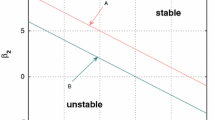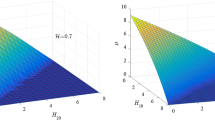Abstract
The asymptotic Lyapunov stability with probability one of multi-degree-of freedom quasi-partially integrable and non-resonant Hamiltonian systems subject to parametric excitations of combined Gaussian and Poisson white noises is studied. First, the averaged stochastic differential equations for quasi partially integrable and non-resonant Hamiltonian systems subject to parametric excitations of combined Gaussian and Poisson white noises are derived by means of the stochastic averaging method and the stochastic jump-diffusion chain rule. Then, the expression of the largest Lyapunov exponent of the averaged system is obtained by using a procedure similar to that due to Khasminskii and the properties of stochastic integro-differential equations. Finally, the stochastic stability of the original quasi-partially integrable and non-resonant Hamiltonian systems is determined approximately by using the largest Lyapunov exponent. An example is worked out in detail to illustrate the application of the proposed method. The good agreement between the analytical results and those from digital simulation show that the proposed method is effective.




Similar content being viewed by others
References
Ling, Q., Jin, X.L., Li, H.F., Huang, Z.L.: Lyapunov function construction for nonlinear stochastic dynamical systems. Nonlinear Dyn. 72(4), 853–864 (2013)
Huang, Z.L., Jin, X.L., Zhu, W.Q.: Lyapunov functions for quasi-Hamiltonian systems. Probab. Eng. Mech. 24(3), 374–381 (2009)
Grigoriu, M.: Lyapunov exponents for nonlinear systems with Poisson white noise. Phys. Lett. A 217(4), 258–262 (1996)
Zhu, W.Q.: Lyapunov exponents and stochastic stability of quasi-non-integrable Hamiltonian systems. Int. J. Non-Linear Mech. 21, 569–579 (2004)
Zhu, W.Q., Huang, Z.L., Suzuki, Y.: Stochastic averaging and Lyapunov exponent of quasi partially integrable Hamiltonian systems. Int. J. Non-Linear Mech. 37, 419–437 (2002)
Zhu, W.Q., Huang, Z.L.: Lyapunov exponents and stochastic stability of quasi-integrable-Hamiltonian systems. J. Appl. Mech. 66, 211–217 (1992)
Khasminskii, R.Z.: Sufficient and necessary conditions of almost sure asymptotic stability of a linear stochastic system. Theory Probab. Appl. 12, 144–147 (1967)
Kozin, F., Zhang, Z.Y.: On almost sure sample stability of nonlinear differential equations. Probab. Eng. Mech. 6(2), 92–95 (1991)
Roberts, J.B., Spanos, P.D.: Stochastic averaging: an approximate method of solving random vibration problems. Int. J. Non-Linear Mech. 21, 111–134 (1986)
Zhu, W.Q.: Stochastic averaging method in random vibration. J. Appl. Mech. Rev. 41(5), 189–199 (1988)
Zhu, W.Q.: Recent developments and applications of stochastic averaging method in random vibration. Appl. Mech. Rev. 49(10), s72–s80 (1996)
Ariaratnam, S.T., Tam, D.S.F.: Lyapunov exponents and stochastic stability of coupled linear system. Probab. Eng. Mech. 6, 151–156 (1991)
Ariaratnam, S.T., Xie, W.C.: Lyapunov exponents and stochastic stability of coupled linear system under real noise excitation. J. Appl. Mech. 59, 664–673 (1992)
Xu, Y., Wang, X.Y., Zhang, H.Q., Xu, W.: Stochastic stability for nonlinear systems deriven by L\(\acute{\text{ e }}\)vy noise. Nonlinear Dyn. 68(1–2), 7–15 (2012)
Wojtkiwicz, S.F., Johnson, E.A., Bergman, L.A., Grigoriu, M., Spencer, B.F.: Response of stochastic dynamics systems deriven by additive Gaussian and Poisson white noise: solution of a forward generalized Kolmogorov equation by a spectral finite difference method. Comput. Methods Appl. Mech. Eng. 168, 73–89 (1999)
Zhu, H.T., Er, G.K., Iu, V.P., Kou, K.P.: Probabilistic solution of nonlinear oscillators excited by combined Gaussian and Poisson white noises. J. Sound Vib. 330, 2900–2909 (2011)
Jia, W.T., Zhu, W.Q., Xu, Y.: Stochastic averaging of quasi-non-integrable Hamiltonian systems under combined Gaussian and Poisson white noise excitations. Int. J. Non-Linear Mech. 51, 45–53 (2013)
Jia, W.T., Zhu, W.Q., Xu, Y., Liu, W.Y.: Stochastic averaging of quasi-integrable and resonant Hamiltonian systems under combined Gaussian and Poisson white noise excitations. J. Appl. Mech. 81(4), 014009 (2014)
Jia, W.T., Zhu, W.Q.: Stochastic averaging of quasi-partially integrable Hamiltonian systems under combined Gaussian and Poisson white noise excitations. J. Phys. A 398, 125–144 (2014)
Jia, W.T., Zhu, W.Q.: Stochastic averaging of quasi-integrable and non-resonant Hamiltonian systems under combined Gaussian and Poisson white noise excitations. Nonlinear Dyn. 76(2), 1271–1289 (2014). doi:10.1007/s11071-013-1209-9
Liu, W.Y., Zhu, W.Q., Xu, W.: Stochastic stability of quasi non-integrable Hamiltonian systems under parametric excitations of Gaussian and Poisson white noises. Probab. Eng. Mech. 32, 39–47 (2013)
Liu, W.Y., Zhu, W.Q., Jia, W.T.: Stochastic stability of quasi-integrable and non-resonant Hamiltonian systems under parametric excitations of combined Gaussian and Poisson white noises. Int. J. Non-Linear Mech. 58, 191–198 (2014)
Di Paola, M., Falsone, G.: \(It\hat{o}\) and Stratonovich integrals for delta-correlated processes. Probab. Eng. Mech. 8(3), 197–208 (1993)
Lin, Y.K., Cai, G.Q.: Probabilistic Structural Dynamics: Advanced Theory and Applications. McGraw-Hill, New York (1993)
Di Paola, M., Vasta, M.: Stochastic integro-differential and differential equations of non-linear systems excited by parametric Poisson pulses. Int. J. Non-Linear Mech. 32(5), 855–862 (1997)
Hanson, F.B.: Applied Stochastic Processes and Control for Jump-Diffusions: Modeling, Analysis, ZND Computation. SIAM, Philadelphia (2007)
Di Paola, M., Falsone, G.: Stochastic dynamics of nonlinear systems driven by non-normal delta-correlated process. J. Appl. Mech. 60, 141–148 (1993)
Khasminskii, R.Z.: On the averaging principle for stochastic \(It\hat{o}\) equation. Kibernetika 4, 260–279 (1968)
Zhu, W.Q., Yang, Y.Q.: Stochastic averaging of quasi-non-integrable-Hamiltonian systems. J. Appl. Mech. 64, 157–164 (1997)
Zeng, Y., Zhu, W.Q.: Stochastic averaging of quasi-nonintegrable-Hamiltonian systems under Poisson white noise excitation. J. Appl. Mech. 78(2), 021002 (2011)
Acknowledgments
The work reported in this paper is supported by the National Natural Science Foundation of China under Grant Nos. 10932009, 11072212, 11272279, and the Basic Research Fund of Northwestern Polytechnic University under Grant No. JC201242.
Author information
Authors and Affiliations
Corresponding author
Appendices
Appendix 1
The SDEs for system (33)are:
Appendix 2
The other coefficients of Eqs. (36) and (37) are:
Appendix 3
The other coefficients of Eq. (47) are:
Appendix 4
In Figs. 2, 3 and 4, the simulation results for stability domain boundary presented by points are obtained as follows. First, draw the theoretical boundary in plane \((\beta _{11}, \beta _{22}+\beta _{33})\) using Eq. (47) with the given parameters. Then, for every \(\beta _{11} \), take one value of \(\beta _{22}+\beta _{33}\) near the theoretical boundary, and solve Eq. (33) with small initial system state near trivial solution using the fourth-order Runger–Kutta method. After long time, if system state approaches to trivial solution, then the point \((\beta _{11}, \beta _{22}+\beta _{33})\) is in stable domain. Otherwise, it is in unstable domain. The procedure of this digital simulation please see Appendix B of [21]. It has been described in [21] in detail.
Rights and permissions
About this article
Cite this article
Liu, W., Zhu, W., Jia, W. et al. Stochastic stability of quasi-partially integrable and non-resonant Hamiltonian systems under parametric excitations of combined Gaussian and Poisson white noises. Nonlinear Dyn 77, 1721–1735 (2014). https://doi.org/10.1007/s11071-014-1413-2
Received:
Accepted:
Published:
Issue Date:
DOI: https://doi.org/10.1007/s11071-014-1413-2




